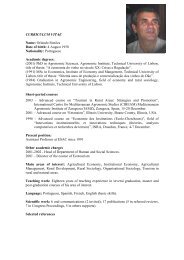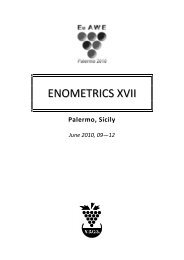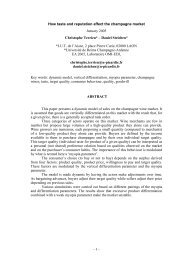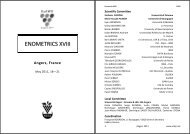The Chilean wine industry: new international strategies for ... - Emerald
The Chilean wine industry: new international strategies for ... - Emerald
The Chilean wine industry: new international strategies for ... - Emerald
Create successful ePaper yourself
Turn your PDF publications into a flip-book with our unique Google optimized e-Paper software.
<strong>The</strong> <strong>Chilean</strong> <strong>wine</strong> <strong>industry</strong>: <strong>new</strong><br />
<strong>international</strong> <strong>strategies</strong> <strong>for</strong> 2020<br />
Christian Felzensztein<br />
Christian Felzensztein is a<br />
Professor of International<br />
Marketing in the School of<br />
Business at Universidad<br />
Adolfo Ibanez, Santiago,<br />
Chile.<br />
This study is part of the www.<br />
clusterinnovation.com research<br />
network (SOC30), Conicyt<br />
Research Council, Chile.<br />
Disclaimer. This case is written<br />
solely <strong>for</strong> educational purposes<br />
and is not intended to represent<br />
successful or unsuccessful<br />
managerial decision making.<br />
<strong>The</strong> author/s may have<br />
disguised names; financial and<br />
other recognizable in<strong>for</strong>mation<br />
to protect confidentiality.<br />
1. Introduction<br />
<strong>The</strong> <strong>Chilean</strong> <strong>wine</strong> <strong>industry</strong> has undergone numerous and profound trans<strong>for</strong>mations over the<br />
past 30 years – its quality revolution led by the complete technological renovation during the<br />
1980s, the export boom of the 1990s, and the <strong>new</strong> terroir developments during the 2000<br />
decade. This trans<strong>for</strong>mation has allowed a <strong>new</strong> generation of talented viticulturists and<br />
<strong>wine</strong>makers to capitalize on Chile’s viticultural paradise and to produce World Class Wines<br />
of unique character and personality.<br />
Chile is the world’s eighth largest <strong>wine</strong> producer and the fifth largest exporter, reaching a<br />
market share of 8 per cent by volume of the global <strong>international</strong> <strong>wine</strong> market at the close of<br />
2010. However, and most importantly, Chile exports 70 per cent of its <strong>wine</strong> production,<br />
making it the world’s most globalized <strong>wine</strong> <strong>industry</strong>, with great flexibility, innovation and a<br />
long-term commitment to quality and service second to none. With 150 destination countries<br />
and 1.5 billion consumers per year, <strong>Chilean</strong> <strong>wine</strong>s are positioned as the country’s most<br />
emblematic and best known world ambassador.<br />
Despite this undeniable success, <strong>Chilean</strong> <strong>wine</strong>s face very high levels of competition in the<br />
different world markets from many appellations and brands, and its average prices are<br />
substantially lower than those of its competitors. As a consequence, the <strong>industry</strong>’s present<br />
profitability levels are low, and there is an urgent need to elevate the premium positioning<br />
and average prices to achieve a sustainable return in the long term. Making decisive<br />
progress toward positioning Chile as a world-class appellation <strong>for</strong> the production of premium<br />
and superior <strong>wine</strong>s, gaining additional image and value is the only possible response to the<br />
competitive challenges the <strong>industry</strong> face today. This is a key requirement <strong>for</strong> the health and<br />
long-term sustainability of Wines of Chile.<br />
<strong>The</strong> <strong>Chilean</strong> <strong>wine</strong> <strong>industry</strong> is preparing a <strong>new</strong> strategic plan and <strong>international</strong> marketing<br />
strategy <strong>for</strong> 2020 aiming guidelines <strong>for</strong> a vigorous ten-year course of <strong>international</strong><br />
development and defines the <strong>industry</strong>’s vision, mission, positioning, strategic objectives,<br />
opportunities and plans of action with a <strong>new</strong> strategic marketing perspective. <strong>The</strong> <strong>industry</strong> is<br />
willing to developed the plan in conjunction with the <strong>wine</strong>ries and key <strong>industry</strong> members, and<br />
with the conviction that this <strong>new</strong> strategy should advance toward a more significant<br />
participation in the world’s premium <strong>wine</strong> segment. Aiming to develop this <strong>new</strong> strategic plan<br />
and <strong>international</strong> marketing strategy, the trade association Wines of Chile, is hiring a <strong>new</strong><br />
consultancy company, and you are part of this team.<br />
2. Objectives<br />
Wines of Chile trade association has set the objective of becoming the number one producer<br />
of premium, sustainable, and diverse <strong>wine</strong>s of the New World by 2020, increasing the<br />
value of bottled <strong>wine</strong> exports over the course of the decade to US$3 billion. This is based on<br />
DOI 10.1108/20450621111115578 VOL. 1 NO. 1 2011, pp. 1-12, Q <strong>Emerald</strong> Group Publishing Limited, ISSN 2045-0621 j EMERALD EMERGING MARKETS CASE STUDIES j PAGE 1
the opportunities and capacities explained and sustained by the historic growth of Chile’s<br />
<strong>wine</strong> exports.<br />
<strong>The</strong> <strong>industry</strong> want to play a key role in Chile’s progress, being convinced of the enormous<br />
potential of Chile’s <strong>wine</strong> <strong>industry</strong>, its importance at the global level as a world-class producer,<br />
and its multiplying effect on the image of Chile. Over the past decade, <strong>wine</strong> has become the<br />
major ambassador of Chile in the minds of <strong>for</strong>eign consumers – as is reflected in the latest<br />
studies conducted by the Fundación Imagen de Chile as well as studies conducted by<br />
Felzensztein et al. (2004) and Felzensztein and Dinnie (2005) – regarding the perception<br />
and knowledge of the country in its principal markets of interest. Wine adds positive and<br />
valuable characteristics to the country image and facilitates the export of <strong>new</strong> products.<br />
<strong>The</strong> Wines of Chile trade association is confident that this <strong>new</strong> strategic plan will serve the<br />
<strong>wine</strong> <strong>industry</strong> and the government’s promotional and development bodies to work together<br />
toward achieving the objectives, <strong>strategies</strong> and commitments set <strong>for</strong>th, aligning the ef<strong>for</strong>ts to<br />
ensure effectiveness. Your aim as a consultant is to build this marketing strategy <strong>for</strong> the<br />
<strong>Chilean</strong> <strong>wine</strong> <strong>industry</strong>.<br />
3. Global consumption<br />
<strong>The</strong> world consumes approximately 236 million hectoliters of <strong>wine</strong> each year. After eight<br />
years of growth, this level fell in 2008 and 2009 as a result of the world economic crisis. <strong>The</strong><br />
European Union decreased its demand, which was partially compensated by an increase in<br />
demand from North America and Asia (Table I).<br />
Although the primary <strong>wine</strong>-consuming countries are France, the USA, Italy and Germany, the<br />
market trend has been toward a decreasing consumption in the large Western European<br />
producing countries and an increasing consumption in <strong>new</strong> consumer countries in Asia and<br />
Latin America, which still have a very low per capita consumption rate.<br />
Surface area planted to vine<br />
Although the world’s overall surface area planted to vine tends to be constant, it has<br />
decreased by 0.8 per cent in the past four years, primarily due to the vineyards that have<br />
been pulled up and subsidized conversions in the European Union in the face of falling<br />
prices, over-production and the impoverishment of the sector. As a result, Spain, France and<br />
Italy, the three countries with the largest plantations in the world, have reduced the number of<br />
hectares planted. <strong>The</strong> primary parties involved are European countries that represent nearly<br />
Table I World <strong>wine</strong> consumption total and per capita<br />
Country Thousand HL LT/Per capita<br />
France 30 47<br />
USA 27 9<br />
Italy 25 42<br />
Germany 20 25<br />
UK 13 21<br />
Spain 11 28<br />
Russia 11 8<br />
Argentina 10 25<br />
China a 9 1<br />
Australia 5 24<br />
Portugal 5 43<br />
<strong>The</strong> Netherlands 3 21<br />
South Africa 3 7<br />
Others 65<br />
Total 237<br />
Note: a Assume a 13 per cent growth over the 2008 figure (available at: www.top<strong>wine</strong>china.com); 2009<br />
estimate<br />
Source: International Organization of Vine and Wine (2010, available at: www.oiv.org)<br />
PAGE 2j j EMERALD EMERGING MARKETS CASE STUDIES VOL. 1 NO. 1 2011
58.4 per cent of the world’s vineyards, particularly Spain, France and Italy. Non-European<br />
countries include the USA and China.<br />
Production<br />
<strong>The</strong> world’s <strong>wine</strong> production fell in 2009 to volumes similar to those produced in 2008: 266 million<br />
hectoliters, a relatively low level of production and similar to that of 2001, 2003, 2007 and 2008.<br />
More than 70 per cent came from European countries, primarily France, Italy and Spain. In the<br />
New World, the USA, Argentina, Australia, South Africa and Chile predominate (Table II).<br />
Exports<br />
Worldwide <strong>wine</strong> sales presented an increasing trend prior to 2009, when it reached 86.1<br />
million hectoliters. Total volume exported (73.5 per cent) is from European countries such as<br />
France, Italy and Spain (Table III).<br />
4. Chile’s national <strong>wine</strong> <strong>industry</strong><br />
In accordance with figures produced by Chile’s Agricultural and Livestock Service (SAG,<br />
www.sag.gob.cl), the country has approximately 121,000 hectares of viniferous vines<br />
Table II World <strong>wine</strong> production<br />
Country<br />
TH HL<br />
Italy 48<br />
France 46<br />
Spain 33<br />
USA 21<br />
Argentina 12<br />
Australia 12<br />
Chile 10<br />
South Africa 10<br />
Germany 9<br />
China 8<br />
Portugal 6<br />
New Zealand 2<br />
Others 51<br />
Total 266<br />
Note: Thousands of HL, 2009 estimate<br />
Source: International Organizational of Vine and Wine (2010, available at: www.oiv.org)<br />
Table III Primary <strong>wine</strong> exporting countries<br />
Country<br />
Thousands of HL<br />
Italy 19<br />
Spain 14<br />
France 13<br />
Australia 8<br />
Chile 7<br />
Germany 4<br />
USA 4<br />
South Africa 4<br />
Argentina 3<br />
Portugal 2<br />
New Zealand 1<br />
Others 8<br />
Total 86<br />
Note: Thousand of HL, 2008<br />
Source: International Organizational of Vine and Wine (2010, available at: www.oiv.org)<br />
VOL. 1 NO. 1 2011 j EMERALD EMERGING MARKETS CASE STUDIES j PAGE 3
planted (2007-2008 registry), and the 2009 production is estimated to be 1.009 billion liters<br />
of <strong>wine</strong>. Exports in the same period reached 694 million liters and US$1.381 billion. Red<br />
varieties comprise 73 per cent of the varieties produced and 27 per cent are white. Of the<br />
red, 63 per cent are those of high demand (Cabernet Sauvignon, Merlot and Syrah). In white<br />
grapes, 66 per cent of the surface area planted corresponds to Sauvignon Blanc and<br />
Chardonnay.<br />
<strong>The</strong> primary export markets in terms of volume are the UK, the USA, Germany, and Canada,<br />
which together represent 50 per cent of the total exports and 34 per cent of the target<br />
markets, including the internal market. As can be observed in Figure 1, most of the decrease<br />
in the share of sales in the internal market has been diverted toward <strong>new</strong> markets rather than<br />
to existing markets. In contrast with the Australian <strong>industry</strong>, Chile has reduced its<br />
concentration.<br />
5. Competition<br />
<strong>The</strong> USA<br />
<strong>The</strong> USA is the world’s fourth largest producer and the sixth largest exporter. Its <strong>industry</strong><br />
depends primarily on Cali<strong>for</strong>nia, which is responsible <strong>for</strong> 90 per cent of the production.<br />
New York, Washington, Oregon, New Jersey and Virginia make up the remaining percentage.<br />
<strong>The</strong> <strong>industry</strong> tended to increase the participation of red varietals in the total surface area<br />
planted from 51 per cent in 1995 to 61 per cent in 2009. With respect to specific white<br />
varietals, Chardonnay has increased dramatically since 1995. Varietals of lesser<br />
consumption on the world level such as Chenin Blanc and Pinot Gris have decreased<br />
their market share. In red varietals, those of greatest consumption worldwide such as<br />
Cabernet Sauvignon, Syrah and Merlot increased their share. <strong>The</strong> internal market continues<br />
to be the primary destination <strong>for</strong> American production, although it has decreased in<br />
importance. <strong>The</strong> <strong>industry</strong>’s primary export destinations are the European Union, Canada,<br />
Japan and Hong Kong (Figure 2).<br />
Australia<br />
<strong>The</strong> average annual production of the world’s seventh largest producer over the past <strong>for</strong><br />
years is 1.4 million liters. <strong>The</strong>re is an upward trend in hectares planted and there<strong>for</strong>e in <strong>wine</strong><br />
production, which is reflected in a greater volume of exports. With respect to varieties<br />
planted, 58 per cent are red varietals and 42 per cent are white. Among the reds, 82 per cent<br />
are those in high demand (Syrah, Cabernet Sauvignon and Merlot). Chardonnay is the<br />
primary white variety and presents an interesting demand in all markets (Figure 3).<br />
Figure 1<br />
Target markets 2000 Target markets 2009<br />
Internal<br />
Others 22% market 46% Others 28%<br />
Internal<br />
market 31%<br />
Denmark 3%<br />
Germany 3%<br />
Canada 6%<br />
UK 9%<br />
USA 11%<br />
Brazil 2%<br />
Denmark 3%<br />
<strong>The</strong> Netherlands 3%<br />
Germany 5%<br />
Canada 4%<br />
UK 11%<br />
Source: Prepared based on in<strong>for</strong>mation from SAG (www.sag.gob.cl) and Wines of Chile<br />
USA 13%<br />
PAGE 4j j EMERALD EMERGING MARKETS CASE STUDIES VOL. 1 NO. 1 2011
Figure 2<br />
Target markets 2000 Target markets 2009<br />
Canada 2%<br />
UK 2%<br />
Others 5% European Union 9%<br />
Canada 3%<br />
Japan 1%<br />
Others 1%<br />
Internal market 91%<br />
Internal market 86%<br />
Source: Wine Institute (2010, available at: www.<strong>wine</strong>institute.org)<br />
Figure 3<br />
Target markets 1999-2000<br />
Others 10%<br />
Internal<br />
Canada 2%<br />
market 58%<br />
New Zealand 3%<br />
USA 7%<br />
New Zealand 2%<br />
Canada 4%<br />
Target markets 2008-2009<br />
Others 16%<br />
Internal<br />
market 36%<br />
UK 20%<br />
USA 20%<br />
Source: AWEC (2009, available at: www.<strong>wine</strong>austrlia.com)<br />
UK 22%<br />
South Africa<br />
South Africa currently has approximately 101,000 hectares planted to <strong>wine</strong> grapes. It has<br />
3.8 per cent of the world’s production, putting it in eighth place on the world scale.<br />
Grapes destined <strong>for</strong> white <strong>wine</strong>s constitute 56 per cent of the total planted, and Chenin Blanc<br />
leads with 19 per cent. Red varieties make up 44 per cent of the total; Cabernet Sauvignon<br />
represents 13 per cent. Owing to the shortage of white <strong>wine</strong>, they have increased the plantations<br />
of Chenin Blanc, Sauvignon Blanc and Chardonnay. Most of South Africa’s production is<br />
consumed in the internal market. <strong>The</strong> majority of the remaining share goes to the UK and<br />
Germany, which together receive 47 per cent of the total exports. Other markets such as<br />
Switzerland and <strong>The</strong> Netherlands follow to a lesser degree. It is noteworthy that although the<br />
USA currently represents 4 per cent, its participation has been increasing (Figure 4).<br />
New Zealand<br />
New Zealand’s <strong>wine</strong> <strong>industry</strong> has doubled its plantations in just six years. Its <strong>wine</strong> production<br />
has increased even more, and the <strong>industry</strong> has shown a strong development in exports with<br />
an average annual growth rate of 33 per cent in the past five years.<br />
In recent years there has been a decrease in the relative importance of Chardonnay with<br />
respect to Sauvignon Blanc and the increase in importance of Pinot Noir over Cabernet<br />
Sauvignon. New Zealand’s primary export markets <strong>for</strong> 2009 were Australia and the UK. It is<br />
important to note the evolution of sales to <strong>for</strong>eign markets, which currently represent<br />
70 per cent of total sales, as opposed to the 34 per cent that it represented in 2000. It is also<br />
VOL. 1 NO. 1 2011 j EMERALD EMERGING MARKETS CASE STUDIES j PAGE 5
Figure 4<br />
Russia 2%<br />
Angola 3%<br />
Sweden 4%<br />
<strong>The</strong><br />
Netherlands 4%<br />
Germany 9%<br />
Target markets 2004 Target markets 2009<br />
Others 17% Internal<br />
Others 17%<br />
consumption 47%<br />
USA 2%<br />
Denmark 2%<br />
Sweden 5%<br />
<strong>The</strong><br />
Netherlands 4%<br />
Germany 9%<br />
UK 14%<br />
UK 17%<br />
Source: Available at: www.sawis.co.za, 2009 – OEMV 2010 (www.oemv.es)<br />
Internal<br />
consumption 45%<br />
interesting to note that Australia, the UK, and the USA reach 12, 12, and 7 per cent,<br />
respectively (Figure 5).<br />
Argentina<br />
With 211,261 hectares of vineyards, Argentina is the fifth largest <strong>wine</strong> producer. It exported<br />
283 million liters in 2009, which represents an increase of 32 per cent over world’s 2008.<br />
Argentina has consistently increased its plantations of red varietals, which have increased<br />
by 150 per cent in 18 years, and in 2008 red varieties were double the number of whites.<br />
Hectares planted to white varieties decreased by 21 per cent during the same time frame. It<br />
is important to note the relevance of rosé <strong>wine</strong>s in the Argentine <strong>industry</strong>. Malbec continues<br />
to be the most planted varietal (25 per cent of all reds), although Cabernet Sauvignon and<br />
Syrah have also increased significantly (18 and 13 per cent, respectively). Among the white<br />
varietals, Chardonnay has experienced the greatest growth.<br />
<strong>The</strong> internal market continues to be the primary destination <strong>for</strong> Argentine production and<br />
represented 79 per cent of the volume sold in 2009. <strong>The</strong> remaining 21 per cent is exported, in<br />
order of volume, primarily to the USA, Paraguay, Russia, the UK, Canada, Brazil and South<br />
Africa. <strong>The</strong> most important markets in terms of value are the USA, the UK, Canada, Brazil, the<br />
Netherlands and Denmark (Figure 6).<br />
France<br />
France continues to be the leading producer and consumer of <strong>wine</strong> worldwide. <strong>The</strong> following<br />
table shows a summary of the primary French figures. Figure 7 shows the importance of the<br />
different destination countries <strong>for</strong> French exports.<br />
Figure 5<br />
Target markets 2000<br />
Target markets 2009<br />
Canada 1%<br />
USA 2%<br />
Others 19%<br />
Others 37%<br />
Internal<br />
market 30%<br />
UK 10%<br />
Australia 2%<br />
Internal<br />
market 66%<br />
Source: Available at: www.nz<strong>wine</strong>.com (2009)<br />
Canada 2%<br />
USA 7%<br />
Australia 12%<br />
UK 12%<br />
PAGE 6j j EMERALD EMERGING MARKETS CASE STUDIES VOL. 1 NO. 1 2011
Figure 6<br />
Target markets 2004<br />
Target markets 2009<br />
Others 10% Others 10%<br />
Brazil 1%<br />
UK 2% UK 1%<br />
Russia 2%<br />
Russia 2%<br />
Paraguay 2% Paraguay 2%<br />
USA 2%<br />
Canada 2%<br />
USA 6%<br />
Internal<br />
consumption 82%<br />
Source: National Vitivinicultural Institute (2009, available at: www.inv.gov.ar)<br />
Internal<br />
consumption 79%<br />
Figure 7<br />
Others 26%<br />
UK 21%<br />
Germany 10%<br />
Switzerland 5%<br />
Canada 4%<br />
Japan 6%<br />
Belgium 11%<br />
Russia 1%<br />
<strong>The</strong> Netherlands 5%<br />
USA 11%<br />
Source: Wines of Chile (2010) based on in<strong>for</strong>mation from national generic<br />
offices<br />
Italy<br />
Italy has a long tradition in the <strong>wine</strong> <strong>industry</strong>, and it reaffirmed its <strong>international</strong> importance in<br />
2009 by maintaining second place in production, exports, and consumption after France.<br />
Italy’s commercial balance in the <strong>wine</strong> <strong>industry</strong> is historically positive. Despite the success of<br />
its exports, however, it has also registered a significant increase in <strong>wine</strong> imports in recent<br />
years. Although it has a minor influence in the overall commercial balance, it makes Italy one<br />
of the largest importers in the world.<br />
It is interesting to note that Italian <strong>wine</strong> production has 470 appellations (denominations of<br />
origin), 316 of which are D.O.C., 35 D.O.C.G., and 119 I.G.T. <strong>The</strong>re are 650,000 <strong>wine</strong><br />
companies, 25,000 bottlers and 678,868 hectares planted to vine. 50 per cent of the Italian<br />
<strong>wine</strong> production is controlled by cooperatives. Its 2009 production was close to 46 million<br />
hectoliters, which is considerably lower than the average of the past five years. With respect<br />
to the regions, 60 per cent of the production is concentrated in four of the 15 producing<br />
regions: Veneto (17.33 per cent), Emilia Romagna (14.97 per cent), Apulia (13.26 per cent)<br />
and Sicily (12.49 per cent).<br />
Italy’s internal market continues to be the primary destination <strong>for</strong> national <strong>wine</strong> production,<br />
and the primary target markets by volume are Germany, the UK, and the USA. <strong>The</strong> following<br />
table shows the primary figures of the Italian <strong>industry</strong> (Figure 8).<br />
VOL. 1 NO. 1 2011 j EMERALD EMERGING MARKETS CASE STUDIES j PAGE 7
Figure 8<br />
Target markets 2004 Target markets 2009<br />
Others 12% Internal<br />
Others 16%<br />
consumption 67%<br />
USA 5%<br />
USA 5%<br />
UK 4%<br />
UK 5%<br />
Germany 12%<br />
Germany 13%<br />
Internal<br />
consumption 61%<br />
Source: Global Trade Atlas (2010)<br />
Spain<br />
Although Spain has more areas planted to vine than any other country, it is the third largest<br />
producer with an average annual production of 41.6 million hectoliters over the past five<br />
years. <strong>The</strong>re is a downward trend in plantations, while both export volume and value have<br />
increased (except in 2009, due to the global economic crisis).<br />
Germany continues to be Spain’s primary export destination, with a value of US$407 million.<br />
<strong>The</strong> UK follows with 15 per cent and the USA with 10 per cent, while France, the Netherlands<br />
and Switzerland are also relevant markets.<br />
Summary of the evolution of the <strong>Chilean</strong> <strong>wine</strong> <strong>industry</strong> in the global context (Table IV)<br />
Table IV Evolution of exports<br />
France Bordeaux Burgundy Italy Spain Australia Chile USA South Africa New Zealand Argentina<br />
1989 39 28 83 4<br />
1990 38 43 110 4 45<br />
1991 54 65 125 6 28<br />
1992 79 74 147 7 23<br />
1993 103 87 132 9 25<br />
1994 125 110 133 8 23<br />
1995 675 114 129 147 8 197<br />
1996 720 130 184 180 11 112<br />
1997 973 154 216 227 110 13 120<br />
1998 1,150 192 231 272 117 15 109<br />
1999 972 216 234 291 128 17 88<br />
2000 1,764 902 285 267 294 141 19 84<br />
2001 1,586 1,054 338 311 304 177 19 88<br />
2002 1,554 220 69 1,579 1,037 418 349 282 217 23 123<br />
2003 1,502 202 64 1,328 1,281 519 395 349 238 27 185<br />
2004 1,425 178 60 1,427 1,469 584 468 461 268 31 155<br />
2005 1,383 172 64 1,609 1,450 670 418 388 281 51 215<br />
2006 1,472 182 70 1,830 1,434 722 474 405 272 58 293<br />
2007 1,515 193 79 1,883 1,558 787 610 455 313 76 360<br />
2008 1,370 179 66 1,751 1,690 715 589 491 412 89 414<br />
2009 1,251 155 56 1,900 1,440 752 694 418 430 113 283<br />
Growth Rate<br />
1990-1999 11 20 25 14 8 16 72<br />
2000-2009 (%) 23 25 22 1 5 14 12 5 13 22 16<br />
Note: For those countries <strong>for</strong> which there is no available data, the average is calculated based on available years<br />
Source: Wines of Chile (2010) based on in<strong>for</strong>mation from national generic offices<br />
PAGE 8j j EMERALD EMERGING MARKETS CASE STUDIES VOL. 1 NO. 1 2011
6. Consumers<br />
Wine consumers<br />
<strong>The</strong> <strong>Chilean</strong> <strong>industry</strong>’s primary target markets are the USA, the UK and Canada. <strong>The</strong> main<br />
consumer-level trends in those markets are:<br />
B<br />
B<br />
B<br />
B<br />
B<br />
B<br />
A change in consumer habits. <strong>The</strong> <strong>new</strong> consumers are intelligent, they seek good value,<br />
and spend more time socializing at home, especially as a result of the global economic<br />
crisis. <strong>The</strong>y are trading down <strong>for</strong> personal consumption, but trading up with friends and<br />
family. For example, 53 per cent of the consumers in the USA are dining at home more<br />
often. Television food channels and food-related blogs are increasing in popularity. Once<br />
the crisis has passed, we can expect that these consumers will return to higher priced<br />
<strong>wine</strong>s, although they will not reach the same levels they did in the late 1990s and early<br />
2000s.<br />
A <strong>new</strong> segment has appeared. <strong>The</strong> ‘‘Millennials’’ are consumers from 21 to 29 years of<br />
age and represent 70 million consumers in the USA alone. 40 per cent of the <strong>wine</strong> they<br />
drink is imported. <strong>The</strong>y learn and communicate on-line. <strong>The</strong>se <strong>new</strong> consumers drive the<br />
<strong>new</strong> trends.<br />
Consumers have greater access to a broader range of <strong>wine</strong>s through <strong>new</strong> products and<br />
distribution channels, such as on-line sales.<br />
Consumers are increasingly more sophisticated and in<strong>for</strong>med. <strong>The</strong>y seek out natural,<br />
sustainable and organic products.<br />
New trends lean toward <strong>wine</strong>s with lower alcohol levels and a greater consumption of<br />
White and rosé <strong>wine</strong>s.<br />
Social networks (Facebook, Twitter and blogs) are increasingly important and allow<br />
low-cost, high-frequency communication with bloggers and consumers around the world.<br />
Image of Chile in target consumer market<br />
<strong>The</strong> most relevant variables <strong>for</strong> mass consumers of the most important markets <strong>for</strong> the<br />
<strong>industry</strong> are varietal, promotions, recommendations and origin (country or region) (Tables V<br />
and VI).<br />
Consumers in the USA and the UK have a low affinity with Chile, which is not true of Australia,<br />
New Zealand, Italy and France. This is consistent several country image studies that<br />
conclude that Chile has a neutral or nil image among <strong>international</strong> consumers at the mass<br />
level. This implies that <strong>for</strong> mass consumers, <strong>Chilean</strong> <strong>wine</strong> is a product of unknown origin.<br />
Although higher-income and more frequent <strong>wine</strong> consumers from the USA drink <strong>Chilean</strong><br />
<strong>wine</strong>s, they have a low affinity with the country. <strong>The</strong> cases of Italy and Australia stand out in<br />
Table V Relevant variables at time of <strong>wine</strong> purchase<br />
Important or very important (%)<br />
UK<br />
USA<br />
Variety 79 73<br />
Promotional offer 65 51<br />
Recommendation of friends of family 63 71<br />
Country of origin 60 47<br />
Region of origin 57 47<br />
Recognized brand 54 69<br />
Alcohol level 33 33<br />
Recommendation from store personnel 29 52<br />
Bottle appearance of label design 26 33<br />
Medal or Award 21 21<br />
Source: Vinitrac (2009)<br />
VOL. 1 NO. 1 2011 j EMERALD EMERGING MARKETS CASE STUDIES j PAGE 9
Table VI Country affinity<br />
Positive or very positive responses (%)<br />
USA<br />
UK<br />
Australia 73 78<br />
Italy 71 66<br />
New Zealand 61 70<br />
Spain 56 62<br />
USA nd 47<br />
Germany 49 38<br />
France 46 56<br />
Portugal 43 47<br />
Argentina 32 28<br />
Chile 29 35<br />
South Africa 21 39<br />
Note: With people, culture, or other<br />
Source: Vinitrac (2009)<br />
that there is coherence between the positive perception of the country and regular<br />
consumption of <strong>wine</strong>s from those regions. Figure 9 shows these country image trends.<br />
7. Economic importance of the <strong>industry</strong><br />
One of the <strong>Chilean</strong> government’s current policies aims to convert Chile into one of the world’s<br />
top ten exporters of food products over the course of the next ten years. <strong>The</strong> <strong>wine</strong> <strong>industry</strong> is<br />
doing its part to achieve this goal, as Chile is now the fifth largest <strong>wine</strong> exporting country on<br />
the globe. In recent decades Chile’s food and agriculture sector has been deploying a<br />
successful strategy of <strong>international</strong>ization, which has become a pillar of the agro-export<br />
basket and of the country’s economic development. Our fruits and vegetables, <strong>wine</strong>, seeds,<br />
and agricultural and <strong>for</strong>estry products reach hundreds of countries around the world and<br />
provide employment to more than 800,000 people.<br />
Figure 9 Relationships between views about named country and <strong>wine</strong> frequency of<br />
consumption<br />
Percentage of answering<br />
"I drink named country once a month or more"<br />
30<br />
25<br />
20<br />
15<br />
10<br />
5<br />
<strong>The</strong>re is a significant and moderate relationship<br />
y = 0.376x – 0.041<br />
R 2 = 0.547<br />
SA<br />
Chile<br />
Argentina<br />
France<br />
Portugal<br />
Germany<br />
Spain<br />
Australia<br />
0<br />
10 20 30 40 50 60 70 80<br />
Percentage of answering "I have positive-or very positive" views about named country<br />
Source: Vinitrac® US, December 2007; base = US regular <strong>wine</strong> drinkers, n = 2,015<br />
Italy<br />
New Zealand<br />
PAGE 10j j EMERALD EMERGING MARKETS CASE STUDIES VOL. 1 NO. 1 2011
Wine exports make up 2.6 per cent of Chile’s total exports and 14 per cent of exports in the<br />
<strong>for</strong>estry-agriculture-livestock sector (2,009 figures). <strong>The</strong> sector has more than 260<br />
companies with annual exports greater than US$50,000, 21 per cent of which export<br />
more than 100,000 UF (approx. US$4.2 million) per year. This means that the majority –<br />
79 per cent – of Chile’s <strong>wine</strong> exporters are small- and medium-sized companies. Chile<br />
produces an average of 887 million liters of <strong>wine</strong> per year, 70 per cent of which is <strong>for</strong> export<br />
markets, which have grown steadily in value by 11 per cent per year. <strong>The</strong>se exports are sent<br />
to 150 countries, with the USA, the UK, and Canada being the most important markets.<br />
From a domestic perspective, the <strong>wine</strong> <strong>industry</strong> operates in several regions of the country,<br />
from the Coquimbo Region in the north to the Araucanía Region in the south. <strong>The</strong> Maule and<br />
O’Higgins regions have the greatest concentration of area planted to vine (53.4 per cent),<br />
although the Metropolitan, Valparaíso and Biobío regions also have a significant amount. <strong>The</strong><br />
<strong>industry</strong>’s continuous development and geographic diversification have attracted both<br />
domestic and <strong>for</strong>eign investment to historically less-developed zones such as the Maule<br />
Region, which had previously been overlooked as an area worthy of investment. This<br />
development has also benefited the many agents involved in the value chain, including<br />
suppliers of materials, technology and complementary services, and particularly the large<br />
number of grape growers, most of whom are small producers. At the same time, the <strong>wine</strong><br />
<strong>industry</strong> continues to be a major source of tax revenue <strong>for</strong> the government through the<br />
Alcohol Law (ILA). Over the past five years (2005-2009), the Wine ILA accounted <strong>for</strong> an<br />
average of 0.21 per cent of the country’s total tax revenue. In 2009 alone, the <strong>wine</strong> ILA<br />
generated tax revenues of US$58 million.<br />
Recent research conducted by Felzensztein et al. (2011) studied the factors that influence<br />
the development of inter-firm cooperation in marketing in the Chilen <strong>wine</strong> <strong>industry</strong>. <strong>The</strong><br />
results confirmed that location is an important aspect that determines the quality and<br />
features of the product and its resulting appeal to <strong>for</strong>eign markets. It seems that location<br />
benefits associated with collaboration and access to in<strong>for</strong>mation and technologies are rarely<br />
considered compared to the specific benefits associated with terroir. Results also provide<br />
evidence of a focus of co-operation with firms that are located close to the focal firm, and<br />
mainly with those directly involved in its value chain. Emphasis of firms co-operating in<br />
marketing activities designed to attract <strong>new</strong> customers and to strengthen the relationship<br />
with them were found relevant.<br />
Finally, the emerging <strong>wine</strong> tourism <strong>industry</strong> is opening up a <strong>new</strong> area of business that has<br />
great potential, as it offers high-quality employment that not only diversifies risks and<br />
sources of revenue, but also fosters more comprehensive and sustainable development in<br />
the regions and communities in which these services are located.<br />
8. <strong>The</strong> <strong>wine</strong> <strong>industry</strong>’s contribution to developing the country image<br />
More than other <strong>Chilean</strong> products, <strong>wine</strong> reaches millions of homes and consumers around<br />
the world with a well-identified country brand that associates the name ‘‘Chile’’ with quality<br />
and diversity. This makes the brand a unique vehicle <strong>for</strong> positioning the country’s image,<br />
which is considered one of the nation’s strategic assets and also facilitates the introduction<br />
of <strong>new</strong> products and services.<br />
In 2009, Chile exported 42 million cases of <strong>wine</strong>, the equivalent of 510 million bottles. From a<br />
conservative perspective, each bottle is seen by at least three people, which means that the<br />
Brand Chile reaches 1.5 billion people each year. Assuming a moderate cost of US$0.852,<br />
which is the average cost per contact on the Internet in the USA, the value of this impact is<br />
US$1.275 billion per year.<br />
Developing the ‘‘Wine of Chile’’ category in key International markets will improve and<br />
expand Chile’s position in the minds of consumers. Positioning Chile as a country that<br />
produces high-quality <strong>wine</strong>s will rein<strong>for</strong>ce the country’s positive attributes such as good<br />
agricultural practices, high-quality cuisine, attractiveness as a tourist destination, a country<br />
with its own identity and traditions, a good quality of life, and a sociable people who know<br />
how to enjoy themselves and make the most of special occasions, among other qualities.<br />
VOL. 1 NO. 1 2011 j j EMERALD EMERGING MARKETS CASE STUDIES PAGE 11
Keywords:<br />
Wines,<br />
Viticulture,<br />
International marketing,<br />
Marketing,<br />
Marketing strategy<br />
9. What is next?<br />
<strong>The</strong> <strong>wine</strong> <strong>industry</strong> is one of the pillars of <strong>Chilean</strong> agriculture and of the country as a whole. In<br />
addition to its importance <strong>for</strong> exports and investment, its impact on employment, personal<br />
and professional development, the country image and in facilitating <strong>new</strong> <strong>Chilean</strong> exports<br />
make it one of the most emblematic sectors in the nacional economy.<br />
Notwithstanding the above, the <strong>wine</strong> <strong>industry</strong> suffers from low rates of return compared to<br />
other productive sectors, despite having an attractive growth potential. Further development<br />
of the sector will depend on raising Chile’s position as a country of origin <strong>for</strong> premium <strong>wine</strong>s,<br />
and this task will require commitment and support from both the public and private sectors<br />
and, once achieved, will benefit the country as a whole. Now it is time to set up sound<br />
<strong>international</strong> marketing strategy aiming to achieve the above goals.<br />
References<br />
Felzensztein, C. and Dinnie, K. (2005), ‘‘<strong>The</strong> effects of country origin on UK consumers perception of<br />
imported <strong>wine</strong>’’, Journal of Food Products Marketing, Vol. 11 No. 4, pp. 109-17.<br />
Felzensztein, C., Hibbert, S. and Vong, G. (2004), ‘‘Is the country of origin the fifth element in the<br />
marketing mix of imported <strong>wine</strong>’’, Journal of Food Products Marketing, Vol. 10 No. 4, pp. 73-84.<br />
Felzensztein, C., Echecopar, G. and Deans, K. (2011), ‘‘Marketing strategy, innovation and externalities:<br />
the case of the <strong>Chilean</strong> <strong>wine</strong> cluster’’, Journal of Business & Industrial Marketing (<strong>for</strong>thcoming).<br />
Wines of Chile (2010), Several <strong>industry</strong> reports.<br />
Corresponding author<br />
Christian Felzensztein can be contacted at: c.felzensztein@uai.cl<br />
PAGE 12j j EMERALD EMERGING MARKETS CASE STUDIES VOL. 1 NO. 1 2011











